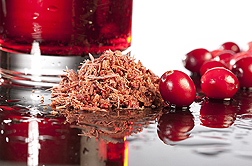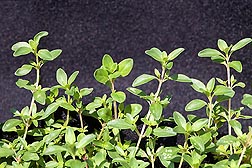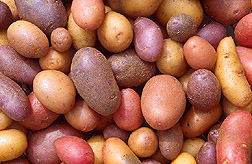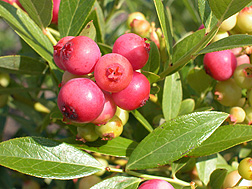| January 2013 |
Technology Enhanced to Evaluate Tenderness and Color Stability in MeatA system designed by Agricultural Research Service (ARS) scientists to predict superior beef tenderness has also been found to be effective at predicting tenderness in pork and color stability in meat. The technology is based on visible and near-infrared reflectance spectroscopy, and can be used without destroying any product from the carcass. Some steaks and chops turn brown more quickly than others, and these often have to be sold at a discount or thrown away. The scientists were able to modify the tenderness test system so it was also able to predict color stability. The researchers also looked at other factors that might influence color stability, including environmental factors such as lighting and oxygen consumption in a display case that mimicked the conditions steaks go through in a traditional supermarket. Variations based on genetics from the pedigrees of 500 animals were also studied, and considerable differences in color stability were found among those animals. That finding suggests color stability might be improved through genetic selection. For details, contact: Steven D. Shackelford, (402) 762-4223, Meat Safety and Quality Research Unit, ARS U.S. Meat Animal Research Center, Clay Center, Neb. |
|
|
|
Researchers Investigate Natural Compounds in CranberriesFresh whole cranberries are known to contain high levels of flavonols—higher than most other berries and, in fact, more than most fruits or vegetables. Agricultural Research Service (ARS)-funded research has now shown that appreciable levels of the total flavonol content of whole berries is in the pomace—the stems, skins, seeds, and pulp that are left over when the berries are pressed to make juice or canned products. Cranberry processors are looking for new, value-added uses for this byproduct. For details, contact: Ronald L. Prior, (501) 364-3309, formerly with the ARS Arkansas Children's Nutrition Center, Little Rock, Ark. |
New Fresh-Market Blueberries Available for Southern ProductionTwo new southern highbush blueberry cultivars—"Gupton" and "Pearl"—developed by ARS researchers will benefit consumers and growers. In addition to high yields of plump, flavorful berries and vigorous growth, the new cultivars should provide a headstart on the lucrative, early-ripening fresh market, which traditionally begins in April and May. In Mississippi field trials, "Gupton" and "Pearl" flowered in mid to late April and were ready for harvest approximately 21 days before the earliest ripening rabbiteye cultivars, the predominant type grown in the South. For details, contact: Stephen J. Stringer, (601) 403-8768, ARS Thad Cochran Southern Horticultural Research Laboratory, Poplarville, Miss. |
|
|
|
Tree Nut Research May Unexpectedly Lead to Medical AdvancesAgricultural research studies on how to control species of Aspergillus mold have attracted the attention of medical and public health researchers. Found worldwide in air and soil, Aspergillus can infect corn, cotton, pistachios, almonds and other crops, and produce aflatoxin, a natural carcinogen. Aflatoxin-contaminated crops must be identified and removed from the processing stream, at times resulting in large economic losses. Since 2004, Agricultural Research Service (ARS) researchers have carefully built a portfolio of potent, plant-based compounds that can kill A. flavus, or thwart its ability to produce aflatoxin. But A. flavus and two related species, A. fumigatus and A. terreus, also can impact the health of immunocompromised individuals exposed to the fungus in moldy homes. Petri-dish experiments suggest that pairing conventional antifungal medicines with the natural, edible compounds from plants—for example, thymol, extracted from the herb thyme—could boost the healing effects of some of the medical drugs. For details, contact: Bruce Campbell, (510) 559-5841, Plant Mycotoxin Research Unit, ARS Western Regional Research Center, Albany, Calif. |
Researchers Create Potatoes with Higher Levels of CarotenoidsAgricultural Research Service (ARS) scientists have bred yellow potatoes with carotenoid levels that are two to three times higher than those of the popular "Yukon Gold" potato. Intensely yellow-fleshed wild potatoes had been found that have about 23 times more carotenoids than white-flesh potatoes. By crossing these wild potatoes with cultivated types, high-carotenoid potatoes were developed. The researchers also developed a potato named "Peter Wilcox" with purple skin and yellow flesh that has become popular in niche roadside markets. The overall carotenoid levels in the "Peter Wilcox" potato are more than 15 percent higher than those in "Yukon Gold." DetailsFor details, contact: Kathy Haynes, (301) 504-7405, Genetic Improvement of Fruits and Vegetables Laboratory, ARS Henry A. Wallace Beltsville Agricultural Research Center, Beltsville, Md. |
|
|
|
Gene Suppression Can Reduce Cold-induced Sweetening in PotatoesPreventing activity of a key enzyme in potatoes could help boost potato quality by putting an end to cold-induced sweetening, according to Agricultural Research Service (ARS) scientists. Cold-induced sweetening, which occurs when potatoes are put into long-term cold storage, causes flavor changes and unwanted dark colors in fried and roasted potatoes. But long-term cold storage is necessary to maintain an adequate supply of potatoes throughout the year. ARS scientists found that during cold storage, an enzyme called invertase causes changes in potato sugars—more accumulation of sucrose—and a corresponding increase in the amount of glucose and fructose in tubers stored at very low temperatures. Decreasing the activity of invertase was found to be sufficient to enable cold storage of potatoes without compromising the appearance of potato chips or the growth characteristics of the potato plants. For details, contact: Paul Bethke, (608) 890-1165, ARS Vegetable Crops Research Unit, Madison, Wis. |
"Pink Lemonade," "Razz," "Sweetheart," and "Cara's Choice": Superb Blueberries from ARS"Razz," a stellar blueberry released by the Agricultural Research Service (ARS) blueberry program in Chatsworth, N.J., offers a flavorful surprise: It tastes quite a bit like a raspberry. "Razz" was bred by the U.S. Department of Agriculture's first blueberry breeder, Frederick W. Coville, in 1934. Originally regarded as too unusual for its time, "Razz" was later rediscovered, newly tested, then officially released last year. Other new releases from the program include "Sweetheart," which produces firm, delectable, medium- to medium-large berries in mid to late June, and also produces a small crop of new berries months later, if the autumn is mild. And some blueberry fans regard "Cara's Choice" as the best blueberry they have ever tasted. It is a very sweet, medium-sized berry that has a pleasant aroma. This berry can be allowed to remain on the plant for several weeks after ripening. It will continue to sweeten, while enabling growers to extend their harvests over a longer period of time. For details, contact: Mark K. Ehlenfeldt, (609) 726-1590, ext. 4421, Marucci Center for Blueberry and Cranberry Research and Extension, Chatsworth, N.J. |
|
|
|
Research Aims to Extend Strawberry Growing Season in Mid-Atlantic RegionGrowing strawberry plants in the U.S. Mid-Atlantic region beneath canopy-like structures called low tunnels can allow the season to start earlier and continue through the summer and fall, according to Agricultural Research Service (ARS) scientists. Strawberry cultivars are being tested in the new production system that could extend the growing season in the northern and eastern United States. For details, contact: Kim Lewers, (301) 504-6768, Genetic Improvement of Fruits and Vegetables Laboratory, ARS Henry A. Wallace Beltsville Agricultural Research Center, Beltsville, Md. |









